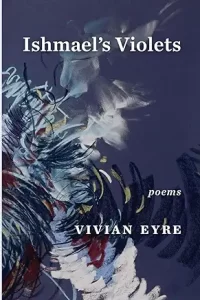A Review of Vivian Eyre’s Ishmael’s Violets
Ishmael’s Violets, Vivian Eyre. Kelsay Books, 2023. 88 pages, $20.00
by Miriam O’Neal
Vivian Eyre’s, Ishmael’s Violets (Kelsay Books, 2023) is a stunner where words meet at the intersection of marine biology, sociology, evolution, and the vagaries of the human heart. Whales give up the land for the sea. Beaches are strewn with natural and human made detritus. Turtles find their way ashore and back into the sea by moonlight. A father sets sail on his final voyage as if out to sea. A friend goes silent.
“Lately I’ve been practicing to stay.” says the speaker in the prologue poem, “What the Sea Told Me.” And from there, as if on a tidal current, we are drawn into and out of worlds of water: sand, seafoam, flotsam, mammals, amphibians, fish, and crustaceans swirl around us. Eyre brings us close to what requires resolve and what needs resolving: how not to wreak havoc on this earth we clearly love; how to plumb the cells of our own bodies for memories of connection; ways to engage with the rest of nature but do no harm.
Eyre opens with the poem, “When Whales Walked.” This brief primer on the evolution and place of the Leviathan, establishes the fact of our mammalian connection and the practicality of evolution. From there she leads us offshore. “Whale Shot,” is a brief ekphrasis in response to an Instagram post of a young kayaker visited by an Orca. We see the young woman touch the Orca’s head and hear the speaker’s response to that moment, “I too have touched wonder/washed my hands without washing/ the one I touched.”
Many lines in these poems work like beads of a Catholic rosary or Buddhist mala, reflecting on our daily personal contradictions and shared understanding. In “The Circle of Several Centers,” we watch a mother orca refuse to accept her calf’s death, pushing it along, trying to “kick-start the lungs.” Eyre recognizes the mother orca’s insistence, swimming so close to loss, the closeness so “visible at the water’s surface,” that denial to the terrible loss of any newborn, the immense and sudden grief unsquareable with the natal journey. As intense is the fact of “The mist of thirty blowholes behind the mother wake,/ each whale taking its turn to push.” “How wide” asks the speaker “is the circumference of loss?” as we witness the pod’s response and consider the dilemma of the need to co-exist versus fulfill competing desires.
Homonyms link species in these poems. In “Considering the Price of a Lobster Roll” we are presented with “Last Rites” but also the possibility of the “last right [whale],” an idea that echoes back to us in “Names that Separate” where the fate of the “right” whale “to kill” faces off with the idea that its name “feels right.”
The most devastating poem in this collection is the lyric written in honor of the 175 orcas who have died in captivity in marine parks. With deft, verbal brushstrokes, the poet shows us how the animals die far from their natural habitat, pod, and offspring. We can’t avoid the immense sin of each death as Eyre reverses the last words of Dido’s Lament. Where the dying Queen of Carthage calls out “Remember me, remember me, but ah! Forget my fate.” In “The End” we are asked to hear the dying orca’s wish, “Don’t remember me, / but ah, remember my fate.” In this brief line, we are called as witness by the very animals our kind have killed—charged with wakefulness, put on notice, again, of our connectedness.
Even as we are confronted with our own complicity, Eyre offers a view, as through a ship’s portal, of the way back/forward to the undeniable fact of our connection. There is a poem in praise of the volunteers who scour the beach for cold-stunned turtles. There are the laws (slowly) catching up with the needs of migrating right whales. Though they are the slightest cuts of the engraver’s birren on the surface of a block of boxwood, they mark a sense of the awakening Rachel Carson encouraged so fervently and eloquently in her writing.
The consequences of both our short-comings, large-heartedness, and sense of connection and wonder spill across these pages. In epistolary poems addressed to various historical and fictional characters, we can trace that gradual awakening pushing against previous eras of refusal or denial. “Letter to Rachel Carson” written on Earth Day, reminds us that Carson loved the sea as much as the land—saw them as a whole. Eyre’s final stanza speaks to Carson’s worry and her own, “If we can separate the forests from the sea, how easily we can disconnect from each other, cleave promises from friendship, screen off the vanished and the vanishing….” In short, we must guard against the convenience of disconnection, not just for human and other animals, but from other humans.
Eyre’s book title comes from a remarkable meditation, on the character Ishmael, of Melville’s, Moby Dick. In “Ishmael’s Hands” as in all of these poems, she works with the material of imagery as with pots of vivid paints, sketching out the scene of the young man on the rendering platform of the Pequod, the whale’s blubber being flensed from its frame.
Ishmael smelled violets while standing
inside the mansion of a whale head,
when the oil was warmest, easiest to bucket
right after slicing off the whale crown.
The sense of immediacy in her details make the moment astonishingly real even from the distance of more than a century. We are there, with Ishmael. But, she explains “Of course, this is all fiction./ Of course, the truth is too large/ for one point of view.” We learn that he couldn’t have known he was smelling violets but are asked/invited just the same to imagine him
tongue-tied with bliss, forgetting
how easy it is to slip
off a keeling ship or into
the oil pool of head gold.
In the closing section of Ishmael’s Violets, we meet the turtles, those totems of good luck, long life, and protection, but also fellow earth/sea dwellers. Their presence stitches shore to sea as they nest above the high tide line, returning to the sea when their work is complete. Harbingers of changing climate, and, like the whales, cohabitors, we are reminded that they all need our wakefulness and regard. Eyre examines the challenge of maintaining that regard in “Catalog of Acceptance,” a poem listing various sources of unresolved separateness humans must address if we are to survive and thrive together in this shared space of earth and sea.
Near the end of the book, in “Widening Rings,” dedicated to Rachel Carson who loved the shore, Eyre shifts from the immense figure of the whale to the lowly limpet in a tide pool.
How much time it takes to see—
as much time as it takes to make a friend—
cunners and hat pin urchins,
snails and gills, rock grit and us.
I’ve read about Aristotle and limpets,
how a muscled foot locomotes
into the sea to feed. How a limpet’s shell
imprints like a scar/tattoo on the home-rock.
And the limpet returns to the same spot.
Aristotle never figured out how
this homing works. A home can be
a room in an inn,
beyond the deep and wide Sheepscot,
sun-dried rocks glistening.
It is all home. We are all home. Eyre’s exquisite poems invite us to remember what we have to share.
Miriam O’Neal has published 3 collections of poetry; We Start With What We’re Given (Kelsay Books 2018), The Body Dialogues (Lily Poetry Review Press 2020), and The Half-Said Things (Nixes Mate Books 2022), as well as poems and reviews in many journals, including, The Galway Review, North Dakota Quarterly, and The Waxed Lemon. She is the Poet Laureate of Plymouth, MA and hosts the poetry reading series, Poetry the Art of Words. For signed copies of her work, contact her at Miriam.e.oneal@gmail.com. You can also order her books from https://kelsaybooks.com/, https://lilypoetryreview.blog/, and https://nixesmate.pub (or from that other place).

